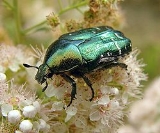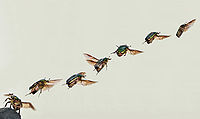
Rose chafer
Encyclopedia
Cetonia aurata, known as the rose chafer
, or more rarely as the green rose chafer, is a beetle
, 20 mm (¾ in) long, that has metallic green coloration (but can be bronze, copper, violet, blue/black or grey) with a distinct V shaped scutellum, the small triangular area between the wing cases just below the thorax
, and having several other irregular small white lines and marks. The underside is a coppery colour.
 Rose chafers are capable of very fast flight
Rose chafers are capable of very fast flight
; they do it with their wing cases down thus resembling a bumble bee. They feed on flower
s, nectar and pollen
, in particular rose
s (from where they get their name); which is where they can be found on warm sunny days, between May and June/July, occasionally to September.
The cetonia aurata pulls the feets inside of the legs and push them out if it is needed.
The larva
e are C–shaped, have a very firm wrinkled hairy body, a very small head and tiny legs; they move on their backs, which is a very quick way to identify them. Larva
e overwinter wherever they have been feeding, that is in compost
, manure, leafmould or rotting wood, and they pupa
te in June/July. Some adult beetles might emerge in the autumn, but the main emergence is in the spring when they mate. Following mating, the females lay their eggs
in decaying organic matter, and then die. Larvae grow very fast, and before the end of autumn they would all have moulted twice. They have a two year life cycle.
Rose chafers are found over southern and central Europe and the southern part of the UK
where they seem to be sometimes very localized. They are a very beneficial saprophagous species (detritivore
), their larvae are the insect equivalent of earth worms and help make very good compost where they are often found in great numbers.
) are known to emit typically left circularly polarised light (see Circular polarization in nature).
Rose chafer
Cetonia aurata, known as the rose chafer, or more rarely as the green rose chafer, is a beetle, 20 mm long, that has metallic green coloration with a distinct V shaped scutellum, the small triangular area between the wing cases just below the thorax, and having several other irregular small...
, or more rarely as the green rose chafer, is a beetle
Beetle
Coleoptera is an order of insects commonly called beetles. The word "coleoptera" is from the Greek , koleos, "sheath"; and , pteron, "wing", thus "sheathed wing". Coleoptera contains more species than any other order, constituting almost 25% of all known life-forms...
, 20 mm (¾ in) long, that has metallic green coloration (but can be bronze, copper, violet, blue/black or grey) with a distinct V shaped scutellum, the small triangular area between the wing cases just below the thorax
Thorax (insect anatomy)
The thorax is the mid section of the insect body. It holds the head, legs, wings and abdomen. It is also called mesosoma in other arthropods....
, and having several other irregular small white lines and marks. The underside is a coppery colour.
Overview

Flight
Flight is the process by which an object moves either through an atmosphere or beyond it by generating lift or propulsive thrust, or aerostatically using buoyancy, or by simple ballistic movement....
; they do it with their wing cases down thus resembling a bumble bee. They feed on flower
Flower
A flower, sometimes known as a bloom or blossom, is the reproductive structure found in flowering plants . The biological function of a flower is to effect reproduction, usually by providing a mechanism for the union of sperm with eggs...
s, nectar and pollen
Pollen
Pollen is a fine to coarse powder containing the microgametophytes of seed plants, which produce the male gametes . Pollen grains have a hard coat that protects the sperm cells during the process of their movement from the stamens to the pistil of flowering plants or from the male cone to the...
, in particular rose
Rose
A rose is a woody perennial of the genus Rosa, within the family Rosaceae. There are over 100 species. They form a group of erect shrubs, and climbing or trailing plants, with stems that are often armed with sharp prickles. Flowers are large and showy, in colours ranging from white through yellows...
s (from where they get their name); which is where they can be found on warm sunny days, between May and June/July, occasionally to September.
The cetonia aurata pulls the feets inside of the legs and push them out if it is needed.
The larva
Larva
A larva is a distinct juvenile form many animals undergo before metamorphosis into adults. Animals with indirect development such as insects, amphibians, or cnidarians typically have a larval phase of their life cycle...
e are C–shaped, have a very firm wrinkled hairy body, a very small head and tiny legs; they move on their backs, which is a very quick way to identify them. Larva
Larva
A larva is a distinct juvenile form many animals undergo before metamorphosis into adults. Animals with indirect development such as insects, amphibians, or cnidarians typically have a larval phase of their life cycle...
e overwinter wherever they have been feeding, that is in compost
Compost
Compost is organic matter that has been decomposed and recycled as a fertilizer and soil amendment. Compost is a key ingredient in organic farming. At its most essential, the process of composting requires simply piling up waste outdoors and waiting for the materials to break down from anywhere...
, manure, leafmould or rotting wood, and they pupa
Pupa
A pupa is the life stage of some insects undergoing transformation. The pupal stage is found only in holometabolous insects, those that undergo a complete metamorphosis, going through four life stages; embryo, larva, pupa and imago...
te in June/July. Some adult beetles might emerge in the autumn, but the main emergence is in the spring when they mate. Following mating, the females lay their eggs
Egg (biology)
An egg is an organic vessel in which an embryo first begins to develop. In most birds, reptiles, insects, molluscs, fish, and monotremes, an egg is the zygote, resulting from fertilization of the ovum, which is expelled from the body and permitted to develop outside the body until the developing...
in decaying organic matter, and then die. Larvae grow very fast, and before the end of autumn they would all have moulted twice. They have a two year life cycle.
Rose chafers are found over southern and central Europe and the southern part of the UK
United Kingdom
The United Kingdom of Great Britain and Northern IrelandIn the United Kingdom and Dependencies, other languages have been officially recognised as legitimate autochthonous languages under the European Charter for Regional or Minority Languages...
where they seem to be sometimes very localized. They are a very beneficial saprophagous species (detritivore
Detritivore
Detritivores, also known as detritophages or detritus feeders or detritus eaters or saprophages, are heterotrophs that obtain nutrients by consuming detritus . By doing so, they contribute to decomposition and the nutrient cycles...
), their larvae are the insect equivalent of earth worms and help make very good compost where they are often found in great numbers.
Colour
The metallic green colouring of the beetle's surface is the reflection of mostly circularly polarised light, typically left circularly polarized light. When viewed through a right circular polariser, they appear to be colourless. Many species of scarab beetles (scarabaeidaeScarabaeidae
The family Scarabaeidae as currently defined consists of over 30,000 species of beetles worldwide. The species in this large family are often called scarabs or scarab beetles. The classification of this family is fairly unstable, with numerous competing theories, and new proposals appearing quite...
) are known to emit typically left circularly polarised light (see Circular polarization in nature).

